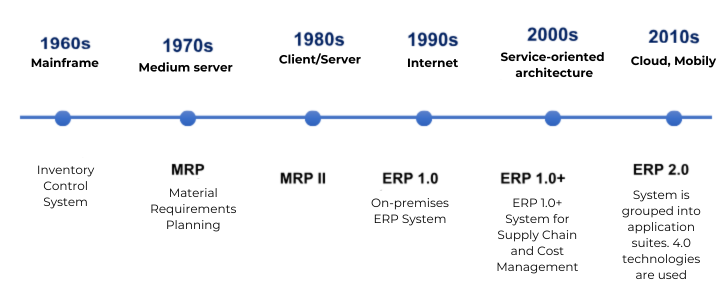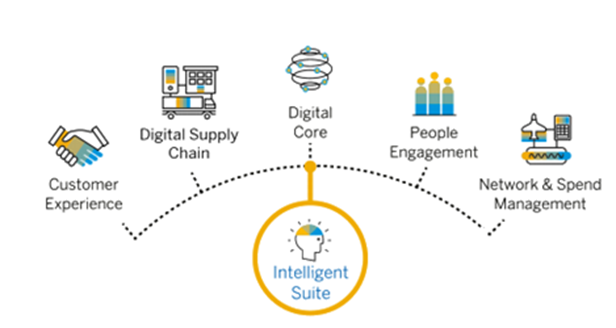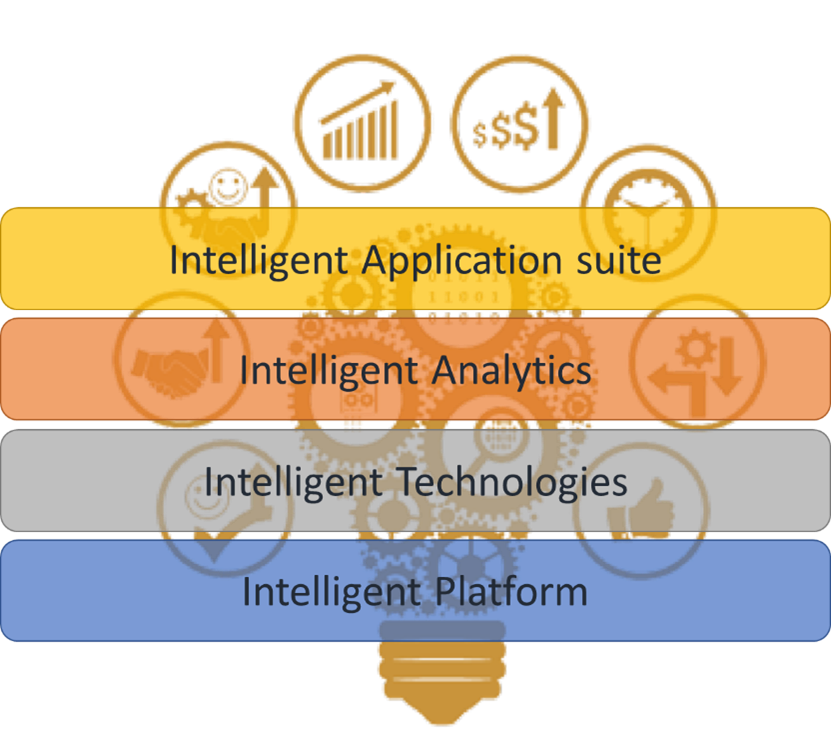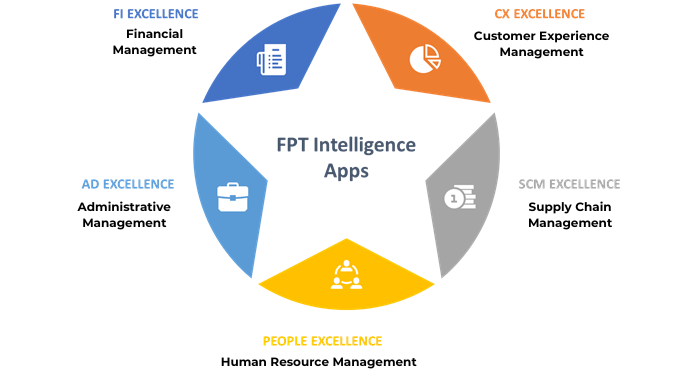ERP 2.0 and FPT Intelligent Enterprise Architecture platform
In the 4.0 revolution era, an inflexible ERP system will hinder businesses’ comprehensive digital transformation. Therefore, good ERP software adds value for both service providers and users by keeping up with the latest trends. The phrase “ERP 2.0” was coined to describe the trend toward flexible ERP system application in business, together with the shift from on-premise to cloud ERP and the integration of fundamental technologies such as AI, IoT, and other smart technologies.
ERP 2.0: from management solution to Digital Transformation platform
The world’s leading ERP solutions have developed into enormously intricate IT systems throughout the last three decades of the 20th century and the early years of the 21st century. For example, Oracle EBS has a database of over 22,000 tables and hundreds of functions spread across over 100 sections. Large ERP systems, which follow the all-in-one philosophy, encompass nearly all significant operational areas within the business, including human resources, supply chain management, customer relationship management, and core operations (finance, purchasing, selling, and production), all of which are managed through a single, and centralized application. Businesses can handle the majority of their operations centrally with the aid of this type of structure, reducing the need to use multiple applications with complicated integration problems. However, over time, such systems gradually reveal many disadvantages, such as:
- The system is too heavy, complex, and has interwoven relationships between operating parts, which makes it difficult to operate, use, fix mistakes, and guarantee performance, especially when it comes to utilizing systems to their full potential. Over many years, the amount of data accumulated is large. Customers who only need to use some basic components still need to install the entire system, leading to waste of resources.
- Upgrading features/versions is difficult because it can affect the entire system. The larger and more important the system, the more it can lag behind the company’s latest version, even by a decade or more.
- Popular ERP solutions often fall short in specialized areas such as human resource management and customer relationship management. Bundling these functions into a single architecture frequently results in poorer customer experience land lower product satisfaction.
- The core technologies of the solution have difficulty accommodating advanced 4.0 technologies such as artificial intelligence, machine learning, cloud computing, big data processing, etc., and thus ERP can no longer be the center of a company’s digital transformation.
Therefore, starting in the 2010s, top solution providers felt driven to give up (i.e., cease development and investment) decades-old ‘golden egg-laying hens’ (such as SAP ECC or Oracle EBS) in favor of developing next-generation ERP solutions like SAP S/4HANA (launched in 2015) and Oracle Fusion Application (first released in 2011). Smaller in scale are ‘late-born’ solutions like Netsuite, Infor, Epicor, and Acumatica that were built from the ground up using cutting-edge technology.
History of Foundation and Development of ERP FPT IS
Some common features of new generation ERP solutions are as follows:
Simplify architecture and group into independent application suites
The new Oracle and SAP solutions all have simpler core technology architectures since they are built on new technologies from the ground up. For example, to fully take advantage of the power of In-memory database technology, the SAP S4/HANA solution uses a single transaction table in place of all summary tables, indexes, histories, etc. in the database, significantly lowering the number of tables for each financial module; for instance, 26 tables in the warehouse module were reduced to just one. The addition of functions to the SAP S/4HANA core that were previously developed as separate, specialized solution packages is another example of how the system has been simplified.
Organizing the solution into application suites that have flexible deployment options and can function independently is another significant change. The figure below shows SAP’s application suites, most of which are marketed under their own brand names, such as SAP SuccessFactor for employee management, SAP Ariba and SAP Concur for network and expense management, and SAP CX for customer experience management. Customers can now select solution sets from several providers that best fit their requirements and have flexibility in selecting the deployment model (on-premises or cloud) for each component.
New Application Suites Of SAP FPT IS
Moving from ‘solution’ to ‘platform’
Modern ERP solutions serve as both management tools and the cornerstone for an organization’s digital transformation thanks to their division into independent solution sets and the objective requirements derived from the 4.0 industrial revolution’s nature and pace of change, particularly:
- Integration platform: enables the integration of ERP core with customer-developed solutions, solution sets from the same or different companies, integration from on-premises to on-cloud, and vice versa.
- Technology platform: offers Internet of Things (IoT), AI, machine learning, and other 4.0 technologies as a service so that users can develop apps to meet specific needs.
- Big data storage and processing platform: offers the capacity to handle and respond to questions using big data instantly, without requiring previous aggregation.
‘Cloud’-centric
Currently available ERP solutions are either cloud enabled or cloud-native. Cloud solutions can help customers lower their total cost of ownership by cutting down on purchasing, maintaining, upgrading, and replacing related hardware and infrastructure. They can also update features more quickly, even on a monthly basis, while causing no interruption to the business activities of their customers. Customers can select from a variety of deployment options, including on-premises, private cloud, or public cloud, depending on which best suits their actual operations.
Focus on smart features and automation
Based on real-time analytics, smart decision features are integrated straight into the business process. The integration of technology like robotics, artificial intelligence, and identification into daily operations improves process automation even more.
As a result, we are seeing a rising number of intelligent, light, flexible, and ‘peaceful coexistence’ ERP systems that also act as an anchor for other applications. These days, ERP has become known as the ‘core’ of business administration and technology, with satellite systems—either self-developed or third-party—that are better suited to address certain corporate operational challenges.
FPT Intelligent Enterprise Architecture – Intelligent enterprise architecture associated with ERP 2.0
The corporate environment changed rapidly in the first decades of the 21st century. The advent of new 4.0 technologies creates new management opportunities and demands, while making digital transformation a direct driving force for business growth. In that context, ERP is still considered the backbone IT system that assists in managing core operations. However, an increasing number of “IT ecosystems” centered around ERP have emerged, with business applications from many suppliers coexisting and closely interacting with ERP. For the following reasons, it seems that this model is becoming more and more effective in Vietnam:
- Businesses require IT applications that reach further along the corporate value chain (to each employee, supplier, and customer) in response to the ever-increasing demands of the business environment. ERP solutions sometimes fall short of this requirement or only partially fulfill it due to their high system complexity.
- IT systems must be updated, enhanced, and upgraded frequently—even on a daily basis—due to the high degree of personalization and the rapid changes in business requirements. Due to the complexity, scale, and quantity of customers of the system, ERP solutions are unable to meet this demand.
- Large ERP companies often offer high-priced advanced solution packages that are unsuitable for Vietnamese enterprises’ budgets.
The downside of the “hundreds of flowers blooming” situation is that the ERP-related applications are not built in accordance with a unified platform architecture, making it difficult for these applications to connect and share data and processes with the ERP core and with one another (even though they may be products of the same solution provider). Additionally, this results in many inadequacies in maintaining and operating the system.
Therefore, in addition to developing and building suitable structures of the FPT Smart Enterprise Architecture, which will serve as the basis for the development of an FPT branded management ecosystem, it is imperative that business management IT applications developed by FPT operate seamlessly and synchronously in customers’ IT ecosystems.
FPT Intelligent Enterprise Architecture includes four layers: Application layer – The suite of enterprise applications surrounding the ERP; Data analysis layer – Services for data analysis based on the datawarehouse/datalake model; Technology layer – FPT-developed 4.0 technology services; Platform layer – IT infrastructure, which includes FPT-packaged and improved open source core platform services and hardware.
FPT Intelligent Enterprise Architecture
This layered architecture allows:
- Thanks to the unification and synchronization of apps inside the FPT ecosystem, customers can choose to deploy one or more products at different times without worrying about connectivity, synchronization, or data sharing between these apps.
- By utilizing the same services as the lower layers, the top layer application will simplify system operation and help customers reduce the total cost of ownership by avoiding the need to invest in different technologies.
- Maintaining backward compatibility and updating technology components should not have an impact on how higher-layer IT applications and services function.
The highest layer of FPT’s Smart Enterprise architecture is a set of smart applications divided into five groups, which can function independently, collaborate with one another and connect to the core ERP software. FPT has built standard connectors for popular ERP solutions from SAP and Oracle, and based on customer needs, it will develop interfaces with additional solutions as well. Application groups include:
- Financial management: includes advanced financial operations such as financial report consolidation (FPT.CFS), financial work automation tools such as input invoice identification (FPT.Digital Accounting), automatic payments connection (FPT.ePayment), and electronic invoices (FPT.eInvoice).
- Distribution channel and customer experience management: An integrated solution for managing sales and distribution channels (ModernSales), delivery and installation management (FPT.Express Delivery), electronic warranty management (FPT.eWarranty), customer relationship management (FPT.CRM), electronic contracts (FPT.eContract), e-commerce platform, and O2O.
- Supply chain management: includes a set of production information management tools/utilities (FPT.MES), smart warehouse management (FPT.WMS), and smart procurement management (FPT.ePurchase).
- Human resource management: includes a set of human resource management solutions (FPT.iHRP) and related solutions including for training management (eLearning).
- Administrative management solutions: includes solutions for process automation and automatic task assignment (FPT.SPRO), and work Management (FPT.SFLASH).
Main solution groups of the application layer in the FPT Technology Ecosystem
A group’s products and solutions are invariably closely linked with one another, and they keep growing by adding new items based on the ideas of process interoperability and wider business coverage.
Datawarehouse/datalake technologies and services, which are included in the second layer of the architecture, enable data collection from applications both inside and outside of the FPT ecosystem, including from ERP. Certain pre-built analytical models, typically the Customer Data Platform (FPT.CDP) facilitate the creation of customer persona (Customer 360), in addition to product persona (Product 360) and employee persona (Employee 360). This information is sent back to upper-layer applications such as ModernSales and CRM to help enhance customer experience and create sales opportunities.
The technology layer includes a collection of key 4.0 FPT-developed technologies such as artificial intelligence and identification (FPT.AI), chatbots, IoT platform (FPT.IoT platform), and digital signatures (FPT.CA). These technologies are packaged as services and used by applications in layer 1 and services in layer 2. These services can also be called by third-party applications/customer-developed applications running on the FPT ecosystem.
The final layer is the cloud computing infrastructure and foundational services such as integration, authentication, microservices, and security built on the basis of open technologies, packaged and refined by FPT. Services at this layer ensure that higher-level applications and services in the ecosystem can be deployed in both on-premises and on-cloud models, ensuring similarity in functionality and experience across both platforms in these two environments.
Aside from the ERP system, the FPT management ecosystem and the FPT Smart Business Architecture platform are significant components in the digital transformation of Vietnamese businesses. They are currently expanding, adding new applications and new technology services, and providing FPT’s customers with exceptional value and experiences.
Exclusively written by the FPT IS Technology Specialist
Vu Minh Quang
Consulting Director, Enterprise Sector, FPT IS Company Limited







